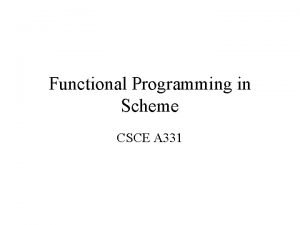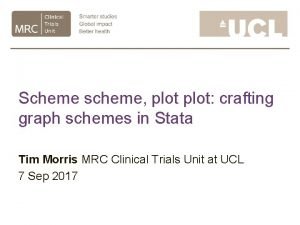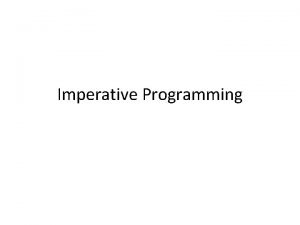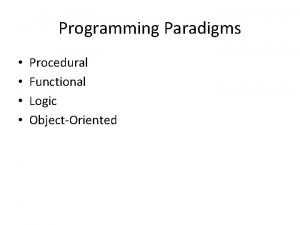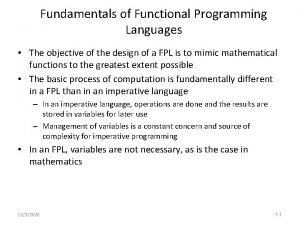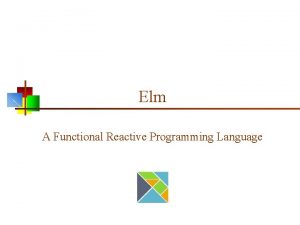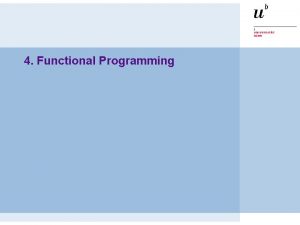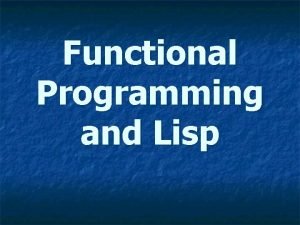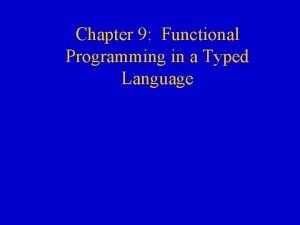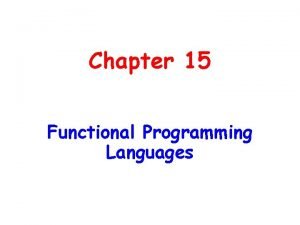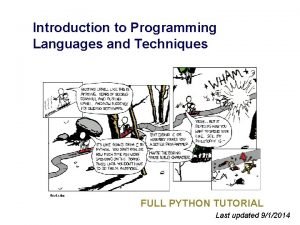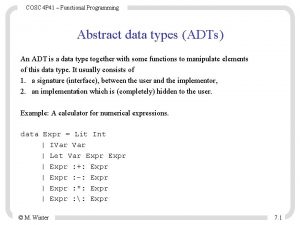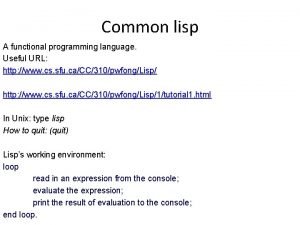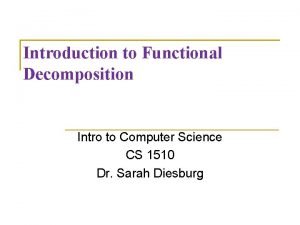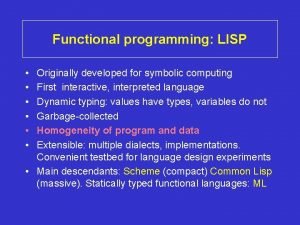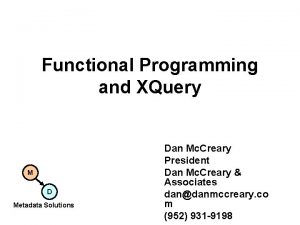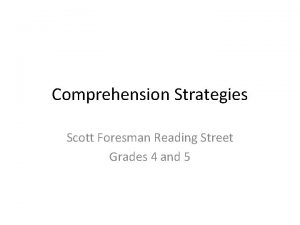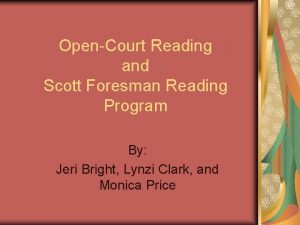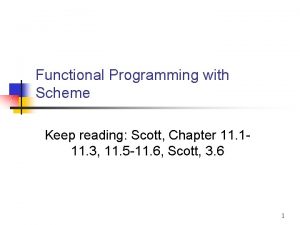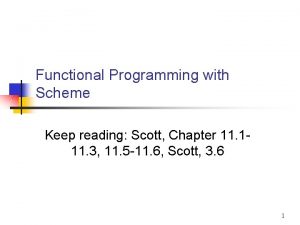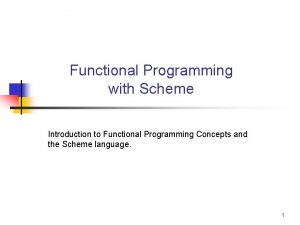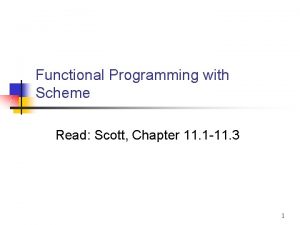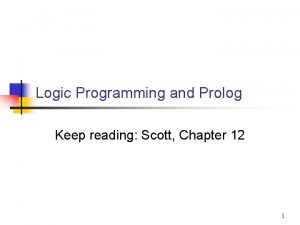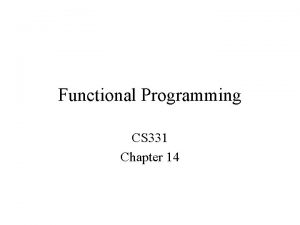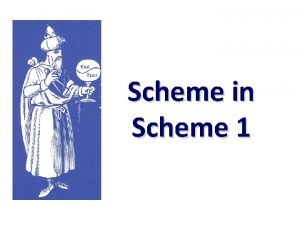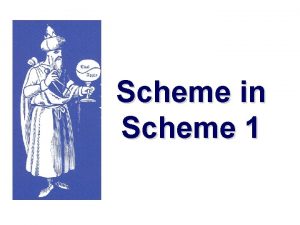Functional Programming with Scheme Keep reading Scott Chapter










































- Slides: 42

Functional Programming with Scheme Keep reading: Scott, Chapter 11. 511. 6 1

Lecture Outline n n Notes on writing “comments” for homework Scheme n Equality testing Higher-order functions n map, foldr, foldl n Tail recursion n Programming Languages CSCI 4430, A. Milanova/B. G. Ryder 2

Writing “Comments” Each function should have the following sections: ; ; Contract: len : (list a) -> integer ; ; Purpose: to compute length of a list lis ; ; Example: (len ‘(1 2 3 4)) should return 4 ; ; Definition: (define (len lis) (if (null? lis) 0 (+ 1 (len (cdr lis))))) Programming Languages CSCI 4430, A. Milanova 3

Writing “Comments” ; ; Contract: ; ; len : (list a) -> number n n n Has two parts. The first part, to the left of the colon, is the name of the function. The second part, to the right of the colon, states what type of data it consumes and what type of data it produces We shall use a, b, c, etc. to denote type parameters, and list to denote the list type Thus, len is a function, which consumes a list whose elements are of some type a, and produces a number 4

Writing “Comments” ; ; Contract: ; ; lis : (list integer) -> (list integer) n lis : is a function, which consumes a list of integers, and produces a list of integers (you may assume that the input is a list of integers) ; ; Purpose: to compute … Programming Languages CSCI 4430, A. Milanova 5

Writing “Comments” n n n Comments are extremely important in Scheme Why? Our “comments” amount to adding an unchecked type signature + an informal behavioral specification Programming Languages CSCI 4430, A. Milanova 6

Lecture Outline n n Notes on writing “comments” for homework Scheme n Equality testing Higher-order functions n map, foldr, foldl n Tail recursion n Programming Languages CSCI 4430, A. Milanova/B. G. Ryder 7

Equality Testing eq? n n Built-in predicate that can check atoms for equal values Does not work on lists in the way you might expect! eql? Our predicate that works on lists (define (eql? x y) (or (and (atom? x) (atom? y) (eq? x y)) (and (not (atom? x)) (not (atom? y)) (eql? (car x) (car y)) (eql? (cdr x) (cdr y)) ))) n equal? n Built-in predicate that works on lists 8

Examples (eql? (eq? ‘(a)) yields what? ‘a ‘b) yields what? ‘b ‘b) yields what? ‘((a)) ‘(a)) yields what? ‘a ‘a) yields what? ‘(a)) yields what? Programming Languages CSCI 4430, A. Milanova/B. G. Ryder 9

Models for Variables n Value model for variables n A variable is a location that holds a value n n I. e. , a named container for a value a : = b l-value (the location) n r-value (the value held in that location) Reference model for variables n n A variable is a reference to a value Every variable is an l-value n Requires dereference when r-value needed (usually, but not always implicit) Programming Languages CSCI 4430, A. Milanova 10

Models for Variables: Example b : = 2; c : = b; n Value model for variables n n b : = 2 c : = b a : = b+c b: c: a: a : = b + c; 2 2 4 Reference model for variables n n n b : = 2 c : = b a : = b+c b c a Programming Languages CSCI 4430, A. Milanova/B. G. Ryder 2 4 11

Equality Testing: How does eq? work? n Scheme uses the reference model for variables! (define (f x y) (list x y)) Call (f ‘a ‘a) yields (a a) x refers to atom a and y refers to atom a. eq? checks that x and y both point to the same place. x Call (f ‘(a)) yields ((a) (a)) x and y do not refer to the same list. y Programming Languages CSCI 4430, A. Milanova/B. G. Ryder x y a A cons cell a ( ) 12

Models for Variables n C/C++, Pascal, Fortran n n Java n n Mixed model: value model for simple types, reference model for class types JS, Python, R, etc. n n Value model Reference model Scheme n Reference model! eq? is “reference equality” (akin of Java’s ==), equal? is value equality 13

Equality Testing n In languages with reference model for variables we have two tests for equality n One tests reference equality, whether two references refer to the same object n n n eq? in Scheme (eq? ‘(a)) yields #f == in Java Other tests value equality. Even if the two references do not refer to the same object, they may refer to objects that have the same value n n equal? in Scheme (equal? ‘(a)) yields #t. equals() method in Java 14

Lecture Outline n n Notes on writing “comments” for homework Scheme n Equality testing Higher-order functions n map, foldr, foldl n Tail recursion n Programming Languages CSCI 4430, A. Milanova/B. G. Ryder 15

Higher-order Functions n n n Functions are first-class values A function is said to be a higher-order function if it takes a function as an argument or returns a function as a result Functions as arguments (define (f (f number? (f len ‘(1 (f (lambda g x) (g x)) 0) yields #t (2 3))) yields what? (x) (* 2 x)) 3) yields what? 16

Higher-order Functions n Functions as return values (define (fun) (lambda (a) (+ 1 a))) (fun 4) yields what? ((fun) 4) yields what? Programming Languages CSCI 4430, A. Milanova/B. G. Ryder 17

Higher-order Functions: map n n Higher-order function used to apply another function to every element of a list Takes 2 arguments: a function f and a list lis and builds a new list by applying the f to each element of lis (define (mymap f lis) (if (null? lis) ‘() (cons (f (car lis)) (mymap f (cdr lis))))) Programming Languages CSCI 4430, A. Milanova/B. G. Ryder 18

map (map f lis) ( e 1 e 2 f f ( r 1 r 2 e 3 … en ) f f r 3 … rn ) There is a build-in function map Programming Languages CSCI 4430, A. Milanova/B. G. Ryder 19

map (define (mymap f l) (if (null? l) ‘( ) (cons (f (car l)) (mymap f (cdr l)) ))) (mymap abs ‘(-1 2 -3 -4)) yields (1 2 3 4) (mymap (lambda (x) (+ 1 x)) ‘(1 2 3)) yields what? (mymap (lambda (x) (abs x)) ‘(-1 2 -3)) yields what? Programming Languages CSCI 4430, A. Milanova/B. G. Ryder 20

map Remember atomcount, calculates the number of atoms in a list (define (atomcount s) (cond ((null? s) 0) ((atom? s) 1) (else (+ (atomcount (car s)) (atomcount (cdr s)))))) We can write atomcount 2, using map: (define (atomcount 2 s) (cond ((atom? s) 1) (else (apply + (map atomcount 2 s))))) Programming Languages CSCI 4430, A. Milanova/B. G. Ryder 21

map (define (atomcount 2 s) (cond ((atom? s) 1) (else (apply + (map atomcount 2 s))))) (atomcount 2 ‘(1 2 3)) yields 3 (atomcount 2 ‘((a b) d)) yields 3 (atomcount 2 ‘(1 ((2) 3) (((3) (2) 1)))) ? 22

Question My atomcount 2 defined below (define (atomcount 2 s) (cond ((atom? s) 1) (else (apply + (map atomcount 2 s))))) has a bug : ). Can you find it? Answer: It counts the null list ‘() as an atom. E. g. , (atomcount 2 ‘()) will return 1. Programming Languages CSCI 4430, A. Milanova/B. G. Ryder 23

Exercise (define (atomcount 2 s) (cond ((atom? s) 1) (else (apply + (map atomcount 2 s))))) Now, let’s write flatten 2 using map (flatten 2 ‘(1 ((2) 3) (((3) (2) 1)))) yields (1 2 3 3 2 1) (define (flatten 2 s) … Hint: you can use (apply append (… Programming Languages CSCI 4430, A. Milanova/B. G. Ryder 24

foldr n n Higher-order function that “folds” (“reduces”) the elements of a list into one, from right-to-left Takes 3 arguments: a binary operation op, a list lis, and initial value id. forldr “folds” lis (define (foldr op lis id) (if (null? lis) id (op (car lis) (foldr op (cdr lis) id)) )) (foldr + ‘(10 20 30) 0) yields 60 it is 10 + (20 + (30 + 0)) (foldr - ‘(10 20 30) 0) yields ? 25

foldr (foldr op lis id) ( ( ( e 1 … … e 1 ) resn-1 en ) en-1 ) res 1 id resn Programming Languages CSCI 4430, A. Milanova/B. G. Ryder 26

Exercise n n What does (foldr append ‘((1 2) (3 4)) ‘()) yield? Recall that appends two lists: (append ‘(1 2) ‘((3) (4 5))) yields (1 2 (3) (4 5)) Now, define a function len 2 that computes the length of a list using foldr (define (len 2 lis) (foldr … Programming Languages CSCI 4430, A. Milanova/B. G. Ryder 27

foldr List element (define (len 2 lis) (foldr (lambda (x y) (+ 1 y)) lis 0)) Partial result ( ( ( a a a 3 b c ) b ) 1 ) 2 0 Programming Languages CSCI 4430, A. Milanova/B. G. Ryder 28

foldr n foldr is right-associative n n E. g. , (foldr + ‘(1 2 3) 0) is 1 + (2 + (3 + 0)) Partial results are calculated in order down the else-branch (define (foldr op lis id) 1 (if (null? lis) id (op (car lis) (foldr op (cdr lis) id)))) Programming Languages CSCI 4430, A. Milanova/B. G. Ryder 2 3 6 () 0 5 3 29

foldl n foldl is left-associative and (as we shall see) more efficient than foldr n E. g. , (foldl + ‘(1 2 3) 0) is ((0 + 1) + 2) + 3 n Partial results are accumulated in id 0 1 (define (foldl op lis id) (if (null? lis) id 1 (foldl op (cdr lis) (op id (car lis)))))3 Programming Languages CSCI 4430, A. Milanova/B. G. Ryder 2 6 3 () 6 30

foldl (foldl op lis id) id ( e 1 e 2 e 3 … e n ) id 1 ( e 2 e 3 … e n ) id 2 ( e 3 … en ) … id n-1 ( en ) CSCI 4430, A. Milanova/B. G. Ryder idn 31

Exercise (define (foldl op lis id) (if (null? lis) id (foldl op (cdr lis) (op id (car lis))))) Define a function rev computing the reverse of a list using foldl E. g. , (rev ‘(a b c)) yields (c b a) (define (rev lis) (foldl (lambda (x y) (… n Programming Languages CSCI 4430, A. Milanova/B. G. Ryder 32

foldl Next element (define (rev lis) (foldl (lambda (x y) (cons y x)) lis ‘())) Partial result () ( a b c (a) ( b c (b a) ( c (c b a) ) () Programming Languages CSCI 4430, A. Milanova/B. G. Ryder 33

Exercise (define (foldr op lis id) (if (null? lis) id (op (car lis) (foldr op (cdr lis) id)) )) (define (foldl op lis id) (if (null? lis) id (foldl op (cdr lis) (op id (car lis)))) ) n n Write len, which computes the length of the list, using foldl Write rev, which reverses the list, using foldr Programming Languages CSCI 4430, A. Milanova/B. G. Ryder 34

Exercise (define (foldl op lis id) (if (null? lis) id (foldl op (cdr lis) (op id (car lis)))) ) n Write len, which computes the length of the list, using foldl (define (len lis) … Programming Languages CSCI 4430, A. Milanova/B. G. Ryder 35

Exercise Can you write the contract for foldl ? (define (foldl op lis id) (if (null? lis) id (foldl op (cdr lis) (op id (car lis))))) ; ; Contract: ; ; foldl : (b * a -> b ) * (list a) * b -> b Programming Languages CSCI 4430, A. Milanova/B. G. Ryder 36

Exercise How about the contract for foldr ? (define (foldr op lis id) (if (null? lis) id (op (car lis) (foldr op (cdr lis) id)))) ; ; Contract: ; ; foldr : (a * b -> b ) * (list a) * b -> b Programming Languages CSCI 4430, A. Milanova/B. G. Ryder 37

foldr vs. foldl (define (foldr op lis id) (if (null? lis) id (op (car lis) (foldr op (cdr lis) id)) )) (define (foldl op lis id) (if (null? lis) id (foldl op (cdr lis) (op id (car lis))) )) n Compare underlined portions of these 2 functions n n foldr contains a recursive call, but it is not the entire return value of the function foldl returns the value obtained from the recursive call to itself! Programming Languages CSCI 4430, A. Milanova/B. G. Ryder 38

Tail Recursion n If the result of a function is computed without a recursive call OR it is the result of an immediate recursive call, then the function is said to be tail recursive n n E. g. , foldl Tail recursion can be implemented efficiently n n Result is accumulated in one of the arguments, and stack frame creation can be avoided! Scheme implementations are required to be “properly tail-recursive” Programming Languages CSCI 4430, A. Milanova/B. G. Ryder 39

Tail Recursion: Two Definitions of Length (define (len lis) (if (null? lis) 0 (+ 1 (len (cdr lis))))) (define (lenh lis total) (if (null? lis) total (lenh (cdr lis) (+ 1 total)))) (define (len lis) (lenh lis 0)) (len '(3 4 5)) Lenh is tail recursive. total accumulates the length Programming Languages CSCI 4430, A. Milanova/B. G. Ryder 40

Tail Recursion: Two Definitions of Factorial (define (factorial n) (cond ((zero? n) 1) ((eq? n 1) 1) (else (* n (factorial (- n 1)))))) (define (fact 2 n acc) (cond ((zero? n) 1) ((eq? n 1) acc) (else (fact 2 (- n 1) (* n acc))))) (define (factorial n) (fact 2 n 1)) fact 2 is tail recursive Programming Languages CSCI 4430, A. Milanova/B. G. Ryder 41

The End Programming Languages CSCI 4430, A. Milanova/B. G. Ryder 42
 Scheme functional programming
Scheme functional programming Stakeholders mapping
Stakeholders mapping What is threat matrix
What is threat matrix Keep it secret keep it safe
Keep it secret keep it safe Pre reading while reading and post reading activities
Pre reading while reading and post reading activities 3 domain scheme and 5 kingdom scheme
3 domain scheme and 5 kingdom scheme Scheme scheme plot plot
Scheme scheme plot plot Consumer financial services pensacola fl
Consumer financial services pensacola fl Space maintainer classification
Space maintainer classification Functional and non functional plasma enzymes
Functional and non functional plasma enzymes Plasma enzymes
Plasma enzymes Functional and non functional
Functional and non functional Scheme programming
Scheme programming Functional programming vs object oriented
Functional programming vs object oriented Fundamentals of functional programming language
Fundamentals of functional programming language Elm lang
Elm lang Functional programming roadmap
Functional programming roadmap Lisp functional programming
Lisp functional programming Typed functional programming
Typed functional programming Fundamentals of functional programming language
Fundamentals of functional programming language Xkcd programming languages comparison
Xkcd programming languages comparison Cosc 4p41
Cosc 4p41 Is lisp a functional programming language
Is lisp a functional programming language Functional decomposition programming
Functional decomposition programming Lisp functional programming
Lisp functional programming Functional programming
Functional programming Scott foresman reading street grade 4
Scott foresman reading street grade 4 Scott foresman reading program
Scott foresman reading program Perbedaan linear programming dan integer programming
Perbedaan linear programming dan integer programming Greedy algorithm vs dynamic programming
Greedy algorithm vs dynamic programming System programming vs application programming
System programming vs application programming Linear vs integer programming
Linear vs integer programming Definisi linear
Definisi linear Chapter 26 how to get and keep credit
Chapter 26 how to get and keep credit St. louis
St. louis Difference between silent reading and reading aloud
Difference between silent reading and reading aloud Kinds of reading skills
Kinds of reading skills Edb net section
Edb net section Words or phrases that associate with critical reading
Words or phrases that associate with critical reading Intensive reading and extensive reading
Intensive reading and extensive reading For adult
For adult Style of reading
Style of reading Python chapter 5 programming exercises
Python chapter 5 programming exercises
